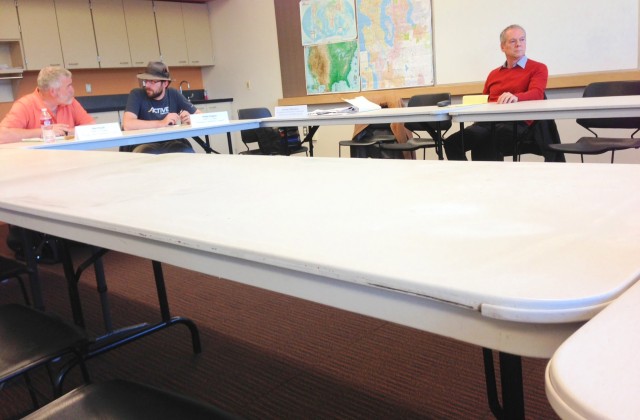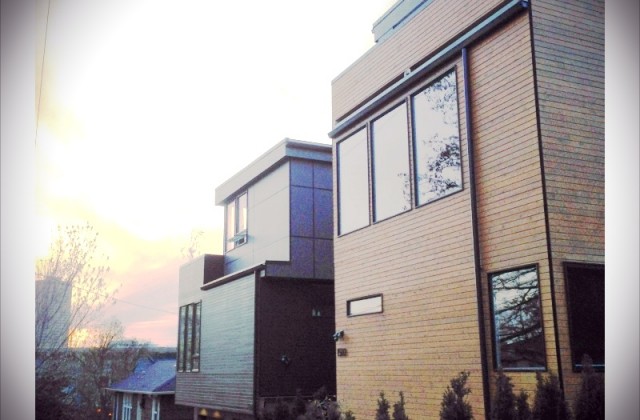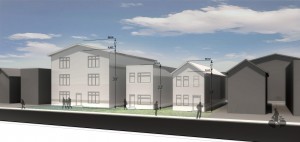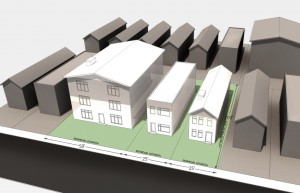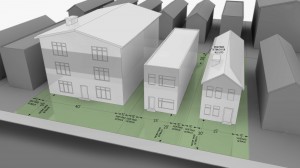Other People’s Housing: Seattle’s Debate Continues
Deciding where to live is a decision that each of us has had to make at one point in our lives. Should we live in a house or an apartment? What part of town should we live in? Do we want a yard or not? Our choices are often limited by our income and our expenses, and, for some, a search for housing can present very few choices because of price. What’s unusual about Seattle’s debate about housing is that it is about trying to decide where and how other people live.
I attended the North District Council meeting where I engaged in a limited debate and question and answer period with John Taylor of One House One Lot. Taylor continues to insist in the face of the facts that not only is everything the same today when it comes to small-lot development, but that Smart Growth Seattle wants to keep it that way. Taylor says, “We have no axe to grind. We’ve already had this happen to us, we just want to stop it from happening everywhere else.” For Taylor “this” means someone new moving into the neighborhood.
I took the time to explain why our Initiative, the passage of the 80 Percent Rule addresses every single one of the issues Taylor’s group brought up last year when they persuaded the Council to pass a legislation ending certain aspects of small-lot development.
- It’s predictable—the 80 Percent Rule allows neighbors to size up their own block and figure out exactly which lots have development potential. Get the square footage of the lots, add together, divide by the number of lots and then multiply by .80 and you’ve got a pretty good sense of what lots are buildable.
- It’s scalable—the other complaint last year was that “these houses are too big!” The 80 Percent Rule has a height limit of 22 feet, shorter than the height limit of regular single-family lots. Taylor continues to insist that our request to keep heights at 22 feet is intended to allow developers to “slip in a third floor.” It’s hard to understand who would live in a four-foot tall floor (the number on the table recently was 18 feet), but perhaps Taylor is worried about Leprechauns moving into the neighborhood. Additionally, our proposal requires set backs, and Taylor’s groups saying that somehow those wily developers will find a way around that too.
- Rhyme and reason—one final issue always brought up was that obscure means were used to create buildable lots out of thin air. But the 80 Percent Rule has a minimum of 2000 square feet for any lot and it is buildable by virtue of its relation to other lots. The historic parcel designation is something that is already off the table, and the proposal from DPD eliminates other designations as well.
But all this is in response to what Taylor’s group thinks about other people’s housing and how it gets built. One neighbor said that building new homes was simply “incremental developer gamesmanship.” That’s it. It’s not about trying to find homes for people that want them, creating jobs and work for people that build them, and adding vitality to the city. Its about not liking where other people live.
It’s important to have these conversations in the neighborhood and I am glad I was invited. But the discussion is still largely about “what this does to me,” rather than “what effect does this have on the overall community.” One neighbor, though, did speak to change.
“As long as people want to live here things are going to change,” she said. “And shouldn’t we be trying to shape that change as long as it’s going to happen.” Yes, we should.
Want to talk about this issue more?
WHAT: Micro-housing development discussion
WHEN: Monday, May 6, 6:00 p.m. – 8:00 p.m.
WHERE: Seattle First Baptist Church
Fellowship Hall (downstairs), 1111 Harvard Ave. (on First Hill)
WHO: Seattle City Councilmembers and Council staff
Representatives from communities and neighborhoods
Representatives of micro-housing developers
North District Council Considers Housing Choice
The local Seattle land use world has been abuzz lately with talk about small, affordable apartments—otherwise known as aPodments. What’s frustrating about all this talk is that it’s almost inevitable that the talk will lead to some kind of action. Members of the City Council feel like they have to do “something” to address the concern of people who fear more housing in their neighborhoods. That “something” is likely to be more regulation that will increase housing price. Erica Barnett at Publicola has written the definitive piece on the meeting of people who hate small, affordable apartments.
The buildings do not currently have to go through design review because, under the city’s land use code, each floor of a building counts as a single unit with several (up to eight) bedrooms, so a building with 56 bedrooms would count as seven units—below the design-review threshold. Although opponents say this is an unfair loophole, proponents—and I’m one—argue that they provide affordable housing to people who otherwise wouldn’t be able to live in the city, and that a lengthy design review process would make that goal harder to attain.
What’s missing from Seattle’s discussion about housing is the idea that people should have more choices about where they want to live in our city. That’s what Smart Growth Seattle is all about: increasing the supply of housing choices for where people live.
Our discussion about housing should be about how to increase those choices across the spectrum of type and size, including small, affordable apartments on one end all the way to new single family homes on the other end and everything in between. After all, what people really want is a place to call “home,” whether they rent or own or their house is small or big. This matters to everyone. When people oppose new places for people to live, they’re making it harder for everyone to find a way to be happy.
If people didn’t want to live in Seattle, our housing prices would drop and we’d be trying to find a way to entice people to live here, including urging businesses to move to Seattle. We don’t have that problem. We don’t have enough housing, which drives up price.
I’ll be at a neighborhood meeting on Wednesday talking about this topic. Please attend if you can.
North District Council
Wednesday, May 1
7:00 p.m.- 8:30 PM
Lake City Library conference room
12501 28th Ave. NE
We need more voices speaking about increasing the choices people have when it comes to housing, so please attend if you can.
“You May Not Like My House, But I love It!”
About 18 months ago, my family and I moved into a new modern home built in beautiful Madison Valley in Seattle. We love the location: its proximity to parks, restaurants, and other amenities, and the fact that it would cut our daily commute to work in half. We love the house built by GreenLeaf Construction. It was nearly a 4 star certified built green home and we upgraded the insulation in the crawl space and replaced the water heater with a 90% efficient one.
The house is fantastic. It has lots of natural light coming in from all angles and the space inside the home is wide open so you can see from one end of the house to the other. The natural light level is so good that we don’t have to turn on any lights in the house until late evening and the house is so well sealed that it very effectively traps the thermal transfer from the sunlight entering the house. This was pretty important to me since I believe strongly in energy conservation and smart engineering.
The home is very attractive to us, and the market demand for these kinds of houses confirms that (see the NYT article on the Bullitt Center to see where contemporary design and building engineering are going in Seattle). Nevertheless, some of our neighbors apparently feel differently and voiced their objections to the building of such homes in sub-plats in our local Nextdoor.com community forum. Given that our house falls squarely into this category as it was built on the side property of our next-door neighbors (who we are very lucky to have as neighbors), I thought I should posit a few thoughts on the matter since, like many things, our understanding of the world around us is very often a matter of perspective.
There is a movement in Seattle called One Home Per Lot, and they claim that such houses are not good for our neighborhoods. Some of my neighbors in an attempt to enlist the support or our community went so far as to call these houses (my house) “ugly boxes” and “unsightly.” I looked at some of the examples they gave of before and after photos where similar such houses had been built in side-yard and back-yard spaces (See photos). In almost every case I actually thought the houses were cool looking and improved the street appeal of the neighborhood. They may not have been like the houses around them, but then you wouldn’t expect a builder to build a new house like something built 30-100 years ago. People lived differently then.
Still, I respect that in a diverse and vibrant urban environment, we will have different aesthetics and opinions on any number of topics. For example, my own mother who is 70 years old probably hates the style of my house, but then she also hated the Levi jeans I wore as a teenager and I suspect she still can’t stand the rock & roll music that I listen to. The difference is that my mother never said to my face that she doesn’t like the style of my house; after all, what would she have to gain by saying so? And therein lies the rub: what do our neighbors have to gain by disparaging these houses and consequently the neighbors who live in them? If your goal is to offend someone, then kudos, otherwise, you missed the mark.
The point of such community organizing for the purpose of influencing municipal rules and policies should be to address empirical issues; otherwise your goal would be to overwhelm city officials with subjective grievances. I’ve read a few of these grievances, such as water pooling up in a side yard or the need to use a sump pump unlike 35 years previously.
Another one involved the loss of view of the neighbor’s trees. These are not empirically based. The legal system established in Western culture is primarily around the rights of property owners and with the founding of our country and a few amendments later, a bunch of individual rights as well.
So which rights are being impacted by builders creating houses on sub-plats? If the builder buys the property, it becomes his/her property and subsequent rights are transferred. I’m not aware of any rights to a view or sky rights. And as for water drainage, I grew up digging perc holes for septic systems, so I’m familiar with different types of soil and how well they drain water. In the Madison Valley/Arboretum area, the soil doesn’t drain well. Just go into the park on a wet day and you’ll see standing water in a grassy field despite the fact that there are no houses around.
To those who wish to influence city policy on future home building, here are a few suggestions:
Make sure the issue you target is empirical; evidence based, and can show real harm. For example, if you could show that building such homes causes long term damage to an existing property, then you have a real complaint.
If, on the other hand, your complaint is that the new home will lower the value of your existing home, then you don’t have a case because that position is highly speculative. Speculation is for stock traders and entrepreneurs, not city/government policy.
The truth is, houses are part of a large marketplace, and markets are always unpredictable. Trying to restrict developers from building new homes is sort of like battling macro-economics. The city of Seattle expects approximately 2 million more people to move into the Seattle Metropolitan area by 2020, which will drive a lot of demand for new homes and properties of all kinds.
The fact is, the Seattle/Bellevue/Kirkland/Redmond corridor is where most of the good jobs are in this area. People are moving into this area because this is one of the places in the country where there are good jobs to be found. And people, like me, want to live closer to where we work because life is short and I don’t want to waste it in a car doing long daily commutes. Be happy that your problems are not like those who live in Detroit.
You can try to restrict developers from building new homes that people clearly want to buy in a city where people clearly want to live, but keep the issues objective. You may not like my house, but I love it and I wouldn’t want any other kind of house. Like I said to my mother long ago, Rock & Roll is here to stay!
It Takes All Kinds: Housing Supply, Choice, and Variety
Housing, like people, comes in all shapes, sizes, and colors. New housing in single-family neighborhoods doesn’t all look the same. Diversity and variety are good things.
Some opponents of new single-family housing argue that new housing is too big. But the facts tell a different story.
Here’s an image that shows a typical block face of singe-family housing. The housing allowed under our proposal are the two houses on the right. The larger house on the left is housing that can be built now on regular single-family lots. Our drawing here shows a slightly larger lot coverage for the bigger house on left (about 550 square feet) than is currently allowed in code. Usually, a home that size would have design features that would lower lot coverage.
Here’s another view.
And here’s a view with more detail on yards for the houses.
Seattle needs more housing choices, including detached single-family houses. Our proposals are pretty straight forward, provide predictability, and would allow housing that fits well with existing houses in neighborhoods all over the city on lots no smaller than 2000 square feet, with height limits, and setbacks. While not every house and every neighborhood is the same, our proposal would allow everyone–builders, new residents, and neighbors–predictable scale for new housing.
Discussion of Small Lot Legislation Heats Up
The good news is that people are paying attention to ideas for finalizing small-lot legislation in Seattle. Last week’s Seattle Channel panel gave us a chance to talk about our initiative and how it would create predictability while still creating more housing supply and choice for Seattle. Monday of this week led off with a front page story in the Seattle Times that was a bit off the mark. The headline screamed about “big houses” on small lots, when, in truth, small-lot proposals on the table will create smaller lots with smaller homes — smaller than what could already be built under the current code on regular, full-size lots.
Thankfully, Erica Barnett at Publicola, responded to the Times story:
So how big are these “BIG HOUSES”? In the example cited by the Times‘ reporter, Lynn Thompson: 1,050 square feet.
Interestingly enough, a quick search through the Times‘ archive finds that the paper has repeatedly referred to apartments and houses the same size as—or, in at least one case, three times the size of—the offending ‘BIG HOUSES” as “shoeboxes.”
In a story from 2003, for example, a Times reporter called a 1,000-square-foot condo a “shoebox” and discussed the creative solutions urban dwellers might consider to manage living in such a tiny, confined space. “This is a new lifestyle to most Northwest natives,” they wrote.
Interesting how context—neighbors angry at change in their single-family neighborhoods vs. urban dwellers comfortable with adjusting to an evolving city—can turn a “shoebox” into a megamansion.
We’ll be doing more work and more public appearances (I’ll likely be on the radio later this week) to make it clear that our proposal is a good one that will create appropriately scaled houses in single-family neighborhoods, not big houses.
Keep letting Councilmembers know you support the 80 percent rule and other aspects of the DPD proposal.
